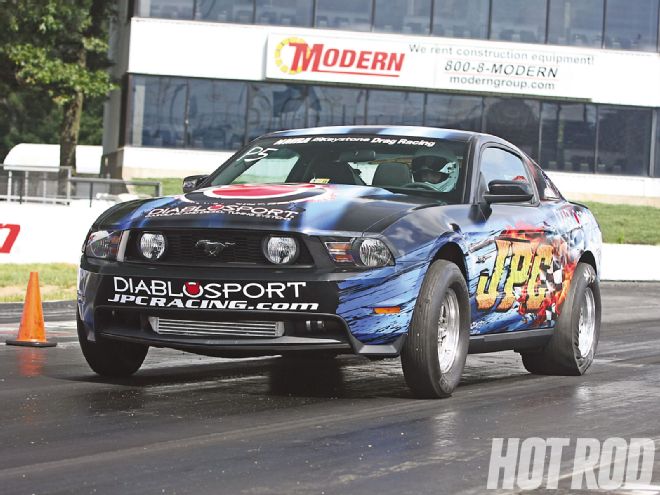
No doubt the Ford Mustang is a survivor. The progenitor of all other ponycars is the only one of its kind to remain in continuous production for more than 45 years (the Corvette is not a ponycar, so no letters, please). The current, fifth-generation platform has been around since 2005, and racers are thoroughly acquainted with its vices and virtues. As with any stocker, once these lead-foots got their hands on the car and started ramping up the power, weak points inevitably manifested themselves. To find out what they are and what you can do about them, HOT ROD consulted leading Ford tuners, including JPC's Justin Burcham, Paul Svinicki at Paul's High Performance, and Lethal Performance's Jared Rosen. These guys actively tune, race, and sell Mustang performance parts. If there's a way to break these cars, they've found it. Unless otherwise stated, all quoted power levels except Ford's factory engine ratings are at the rear wheels, not the flywheel. There can be up to a 15 percent loss through the drivetrain.
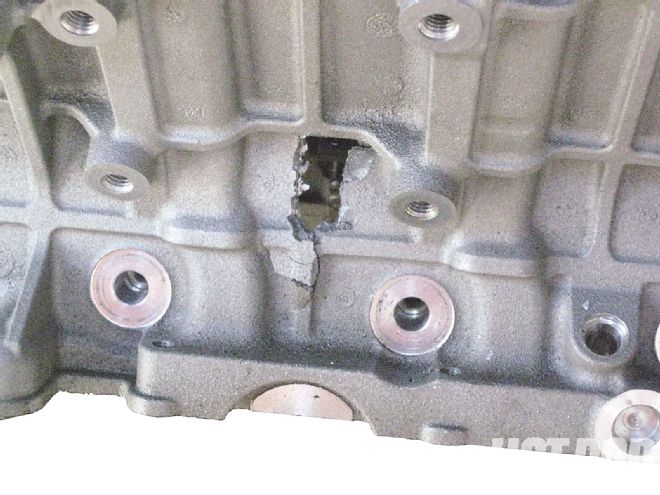 Justin Burcham has run fifth-gen 'Stangs into the ground. His new '11 model runs 9.80s at 143 mph on a stock 5.0L Coyote long-block. This is what happened to an earlier 4.6L three-valve aluminum block when a stock powdered-metal rod let go. If needed, Ford Racing offers 4.6L three-valve Aluminator short-blocks with all-forged rotating assemblies.
Justin Burcham has run fifth-gen 'Stangs into the ground. His new '11 model runs 9.80s at 143 mph on a stock 5.0L Coyote long-block. This is what happened to an earlier 4.6L three-valve aluminum block when a stock powdered-metal rod let go. If needed, Ford Racing offers 4.6L three-valve Aluminator short-blocks with all-forged rotating assemblies.
Engines
'05-'10 4.6L Three-VALVE SOHC
The Mustang GT's standard V8 was factory rated at 300 to 315 hp and 320 to 330 lb-ft.
Phaser flop (6,500 rpm or higher): Running more than 6,500 rpm, stiff springs and/or big cams can override the stock variable valvetrain's camshaft-timing phase mechanism, causing unpredictable and potentially catastrophic cam timing changes. The solution is Comp Cams' phase limitation kit, locking out the phaser, or converting to a nonvariable cam-timing setup.
Con rods break (450 to 500 hp): The stock powdered-metal connecting rods are generally the three-valve motor's weakest link. Burcham has seen random failures of stock rods as low as 450 hp; "500hp and higher for an extended time period will definitely break them."
Pistons disintegrate (detonation): Although not that strong, as a rule, the stock hypereutectic pistons outlast the rods. But if there's even slight detonation, the pistons can shatter into hundreds of pieces. Replace the weak stockers with quality aftermarket forged pistons.
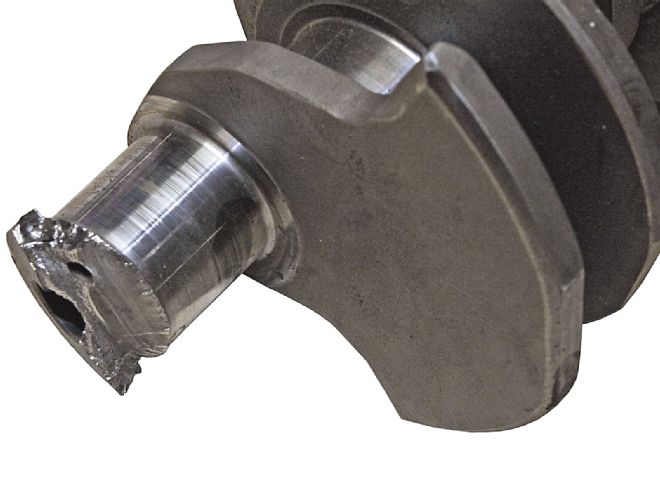 Rip the snout out of it: Although a forging is shown here, this usually happens to a three-valve's nodular-iron crank abused by excessive side loading from a beltdriven centrifugal blower run at high boost. Installing a forged crank in a three-valve requires upgrading from a six-bolt to an eight-bolt flywheel or flexplate.
Rip the snout out of it: Although a forging is shown here, this usually happens to a three-valve's nodular-iron crank abused by excessive side loading from a beltdriven centrifugal blower run at high boost. Installing a forged crank in a three-valve requires upgrading from a six-bolt to an eight-bolt flywheel or flexplate.
'07-'11 5.4L Four-VALVE DOHC
The Shelby GT500 supercharged engine was factory-flywheel-rated at 500 to 550 net hp and 480 to 510 lb-ft.
Con rods break (700 to 750 hp and/or over 6,500 to 6,700 rpm): In Svinicki's experience, "The four-valve's forged rod is better than the one used on the three-valve engine, but the bolts are marginal. As a cracked-cap design, it's hard to upgrade." Burcham adds, "At 800 hp, you can usually send one flying. I've seen them take more abuse than that, but I've also seen them break with less."
Piston and ring problems (750 to 800 hp and/or over 6,500 to 6,700 rpm): The stock forged pistons are fairly durable, but Svinicki says the ring package and pin design are marginal. "A better forged piston like a Diamond or Speed-Pro is highly recommended."
Head gasket problems (high boost): Use head studs under high-boost conditions.
Oil pump upgrade (high boost): Burcham recommends an upgraded billet high-volume oil pump if running high boost and high rpm.
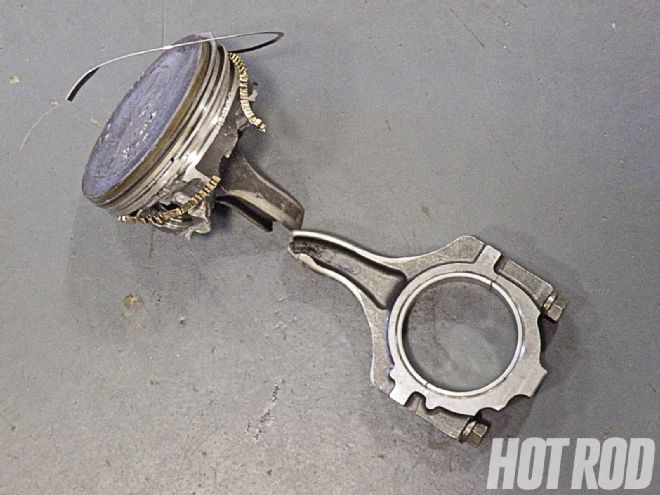 Separation anxiety: When a rod fails, it's often the beam that goes first, as seen here on a three-valve piston/rod assembly at Paul's. The resulting carnage can take out the entire short-block. The fix is a good I- or H-beam aftermarket forged or billet rod.
Separation anxiety: When a rod fails, it's often the beam that goes first, as seen here on a three-valve piston/rod assembly at Paul's. The resulting carnage can take out the entire short-block. The fix is a good I- or H-beam aftermarket forged or billet rod.
'11 5.0L Four-VALVE DOHC
Base power on the Mustang's new standard V8 is 412 hp and 390 lb-ft at the flywheel. So far Burcham is making 750 hp at the wheels at 8,000 rpm on a stock motor with no problems. Svinicki says the engines have been very durable so far. Others aren't so fortunate.
Con rods break (600 to 650 hp): Expect the rods to still be a weak link. Overall strength appears to fall somewhere between the three-valve and the Shelby 5.4L four-valves. Although he's not yet broken any rods personally, Burcham has already received reports of some failures.
Piston disintegration (nitrous or high boost): The pistons remain hypereutectic, so don't expect them to last long under high boost or a big nitrous shot. On the other hand, special oil jets enhance pin oiling, making them marginally better than previous three-valve pistons.
Crankshaft: The new 5.0 motors now use forged cranks. No problems so far.
Ti-VCT problems (more than 6,500 rpm): At present, Comp is leaning toward a kit to lock out the factory Ti-VCT (Twin-independent Variable Cam Timing) actuation when running serious cams.
Fuel system: On the new 52-psi fuel system, it may be harder to alter system pressure and delivery characteristics than before.
Block: With quality rods and good forged pistons, the Coyote's improved aluminum block can easily support 1,500 hp.
Automatic Trans '05-'10 5R55S Five-Speed
The 5R55S automatic overdrive was used behind V6 and three-valve Mustang GT cars. Custom programming is needed to make the trans perform and live under increased power.
Servo bore wear (random/normal driving): Four C's Transmission Specialties' Julian Nieto says the heavy stock servo piston and pin can egg-shape the servo bore resulting in fluid pressure loss and delayed shifts that cause the ECU to set a code. Sonnax sells a tool and kit to sleeve the bore.
Input shaft failure (400 to 450 hp): Svinicki says the spindly 12mm-od input shaft can fail from a hard 5-3 or 5-2 downshift, which takes out the converter, too. One crutch, reports Harvey Baker at Performance Automatic (PA), is to reprogram the computer to retard ignition timing at each shift point. Ultimately, PA offers a beefed-up, hardened, 300M steel shaft.
Internal parts failures (500 hp and up): Internal parts start to wear under extended operation in the 500hp range, reports Burcham. TCI's Scott Miller starts seeing outright hard parts break at 600 hp. Potential problem areas include the servos and bands and clutch apply/disconnect issues. B&M's Steve Macias reports planetary problems; the failure point varies depending on exact driving style and computer programming. Cryogenically treat the planetaries to prolong their life.
Converter clutch failure (extended full-throttle/high rpm): Reprogramming to keep the converter locked up and the trans in Overdrive for extended full-throttle operation overheats and fails the converter clutches. Add a trans cooler and a beefed-up converter.
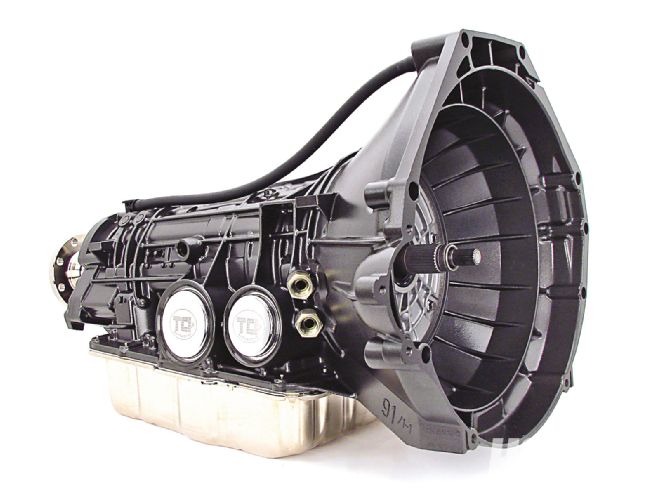 Automatic upgrade: More than 500 hp on a 5R55S calls for heavy-duty internals. The parts as well as complete gonzo transmission assemblies are available from major aftermarket outfits such as PA, B&M, and TCI. This TCI Super Street trans carries a 1,025-flywheel-hp rating.
Automatic upgrade: More than 500 hp on a 5R55S calls for heavy-duty internals. The parts as well as complete gonzo transmission assemblies are available from major aftermarket outfits such as PA, B&M, and TCI. This TCI Super Street trans carries a 1,025-flywheel-hp rating.
'11 6R80 SIX-Speed
Auto trans-equipped '11 Mustangs receive a new six-speed automatic overdrive. It appears to be a pretty durable trans, but the aftermarket learning curve is only just beginning. Any problems are apparently being repaired by Ford under warranty, so at this point it's hard to get a handle on the specifics.
Manual Trans And Clutch '05-'10 TREMEC TR-3650
The integral-bellhousing TR-3650 five-speed was used behind three-valve motors. Although Burcham maintains, "We have run low 10s on the stock trans without breakage," there's little aftermarket support for this trans if you need to beef it up. Caused by missed shifts or improper clutch engagement, synchronizer problems are usually the first things that go wrong, leading to other problems. The 10-spline input shaft is also prone to failure.
'11 Getrag MT-82
The 5.0 engine gets the new Getrag MT-82 six-speed manual trans. It has a 23-spline input shaft, which should be a step up over the 10-spline input used on the TR-3650. Occasional grinding when shifting into Second during normal driving has been reported by some owners, but others swear this trans "shifts like butter." Lethal Performance is making 600 hp at the wheels without problems. On the other hand, "after a rough 1,000 miles," JPC's trans stuck in Third gear (probably a broken shift fork). Ford replaced it under warranty.
'07-'11 TREMEC TR-6060
A descendent of the beefy Tremec T56 six-speed, the TR-6060 is the only trans used behind '07 to '11 Shelby GT500s. D&D has cars running more than 750 hp to the tires with a stock 6060; even stronger Magnum versions are offered. Synchro wear is the only real issue, with Second gear the most problematic. More durable carbon-fiber blocker rings were introduced on the '10 models; they can be retrofitted.
Clutch
Slippage (varies): Factory single-disc clutches start slipping at 400 to 450 hp on the three-valve GT V8s and at around 650 to 700 hp for the dual-disc clutch behind the Shelby four-valve. Install upgraded clutch assemblies available from major aftermarket clutch companies.
Clutch pedal sticks to the floor ('11 5.0, more than 6,700 rpm): An improperly designed clutch pedal is apparently responsible for the clutch failing to release even on stockers. Ford has come out with a service-fix pedal-redesign and upgraded pedal return spring.
Rearend And Driveshaft
All '05-and up Mustangs use a two-piece driveshaft and a Ford 8.8-inch solid rear with 31-spline axles. Stick-shift launches are harder on parts than automatic launches; slicks impart greater shock than street tires.
Axle and differential failures (400 to 550 hp): Axles usually fail first, with diffs a close second. "Most times, a good launch can break the axles right in half," Burcham says. Extend 8.8 life expectancy with C-clip eliminator housing ends, 31-spline or greater aftermarket billet axles, a housing brace, a rear-cover girdle, and an aftermarket diff-either a Detroit Tru-Trac or (for racing only) a spool.
Bent rearend housing (650 hp): Svinicki says sticky tires can bend the housing. He prefers installing a drop-in Moser or Ford Racing 9-inch Ford rearend with 35-spline axles.
Other Issues
Wheelhop: Svinicki says the Mustang "wheelhops straight out of the factory" with the traction-control off, particularly on a stick shift. Upgraded Ford Racing Cobra Jet upper and lower control arms or aftermarket equivalents are needed to control this problem.
Cooling system (525 hp): Mustang GTs upgraded to this level tax the stock radiator.
Fuel system (varies): Upgrades are needed on the Mustang GT over 450 hp normally-aspirated or 400 hp with forced induction. The Ford Racing GT500 dual pump returnless assembly works through 600 hp with properly sized injectors. Beyond that, JPC recommends high-end aftermarket fuel supply systems.
Brakes: Use GT500 brakes if road racing.
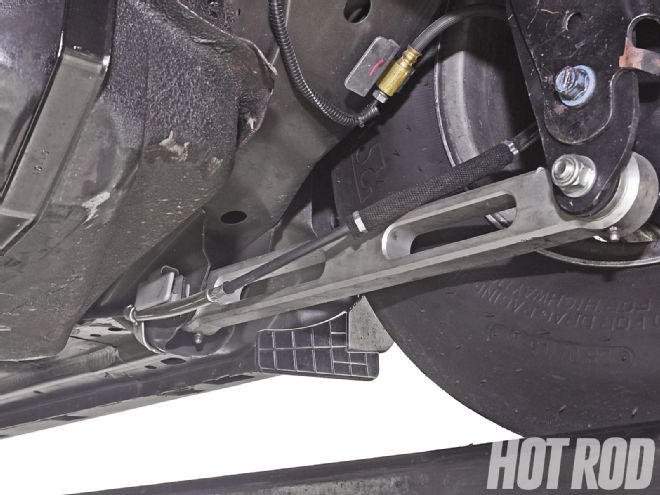 JPC's beefy Metco lower control-arms attach to beefed-up torque boxes in the front and instant center brackets at the rear. Not visible is JPC's own double-adjustable upper control arms.
JPC's beefy Metco lower control-arms attach to beefed-up torque boxes in the front and instant center brackets at the rear. Not visible is JPC's own double-adjustable upper control arms.